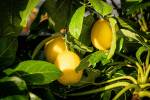Location of palm’s yellowing reveals its health
: I have three quite mature California fan palms, about 25 feet tall, growing about 10 feet apart in a triangle. They get plenty of water, though that's reduced in winter. About a year ago, one of them had a severe yellowing problem that the other two did not, but it's mostly just in the leafy parts. The stems of the fronds remain green, as does the new growth for the first four or five fronds. Also, the fronds don't droop any more than those of the other two palms. It's as if water/nutrition is being blocked from getting all the way out to the leafy parts.
A: It's important which leaves are yellowing. If it is the oldest leaves, or the ones toward the bottom, I am less concerned. If it is the newer leaves, or the leaves closest to the center and pointing more upward (the ones toward the top), then I would be more concerned.
The palm grows from a central bud at the top of the trunk at its center. New growth pushes from this central bud and as leaves get older then they begin to become less upright and more horizontal. Eventually the oldest leaves become brown and collapse around the stem of the palm leaving a "skirt" of dead leaves unless they are removed.
Yellowing of the older leaves, or the ones more horizontal, can be due to cold weather or age. Yellowing of palm fronds or leaves that are more upright, younger and closer to the center can mean a nutrient deficiency or a possible disease problem.
The nutrient problem can be addressed by adding a complete fertilizer that includes iron to the base of the palm and watering it in. You might also try a foliar spray of a complete fertilizer with iron. Use a spreader mixed with the nutrient spray to help it penetrate the waxy leaf of the palm. Spreaders can be purchased at the time you buy your fertilizer at the nursery or you can make some with a teaspoon of liquid detergent in a gallon of water.
The disease problem, if there is one, is harder to address except to wait and see what happens. If it's just the older leaves, then just ignore it and it will be eventually pruned out as you remove older palm fronds.
In the meantime give it a complete fertilizer and make sure your palms are watered deeply and at about the same frequency as your other landscape trees.
Q: I have two potted gardenias that are two years old and are really getting large. Can I prune them back and, if so, when and how much?
A: Gardenias are flowering shrubs and like other flowering shrubs they should be pruned after they have finished blooming in the summer. After their blooming cycle has finished they will begin to set flower buds for the next blooming cycle.
If you prune them before this, then you run the risk of removing a lot of flower buds and reduce or even eliminate the flowers.
They don't require much pruning, just enough to shape them and remove some older wood from the base of the shrub to keep its growth young and renewed.
Q: I recently read your article about rock mulch and how it causes problems for plants/trees. What kinds of problems does this cause and are red cinders any better since they may contain more iron?
A: Rock mulches are usually fine for use around plants that come from desert soils low in organic matter. It becomes a problem when we use it around plants that require soils higher in organic matter content.
The organic matter content helps keep the soils more enriched. Organic mulches slowly decompose and add to the organic matter of the soil, whereas rock mulches do not decompose.
Plants that require higher organic matter content will show signs of nutrient deficiency such as yellowing, scorching of the leaf margins and dieback when grown in rock mulch.
Just adding iron to a soil will not always improve the iron content for plants. Iron can exist in two different forms: ferrous and ferric. The ferrous form is the form that plants can use. The ferric form is not usable by plants.
The red form that you see in minerals is the ferric form . Our desert soils contain mostly iron in the ferric form and so, it too, is not usable. The ferrous form is found in soils with lower alkalinity or lower pH .
So to combat this we supply iron to plants as a chelate, where the ferrous form can be protected from the high alkalinity, or we add the iron along with something to help lower the soil pH, such as sulfur.
Red cinders, even though they may contain a sizeable amount of iron, will not help provide enough iron in a form that would be available for plants to use.
Q: I am thinking about adding an almond tree here in Anthem, Henderson. Do these trees require a pollinator and what is the spread of your recommended variety?
A: I sent you a copy of my newly released fruit tree evaluations for the Las Vegas Valley. The two varieties of almond that I have recommended, Garden Prince and All-in-One, do not require a pollinator.
Keep in mind, these were our top two performers at the University of Nevada Cooperative Extension Master Gardeners Orchard in North Las Vegas. Many almonds do very well in our climate.
These are semidwarf so you can put them as close as 10 feet from each other. They are perfect for backyards. Garden Prince is particularly attractive when in bloom as it has a more purple flower rather than the typical white almond flower.
Bob Morris is an associate professor with the University of Nevada Cooperative Extension. Direct gardening questions to the master gardener hot line at 257-5555 or contact Morris by e-mail at morrisr@unce.unr.edu.






















